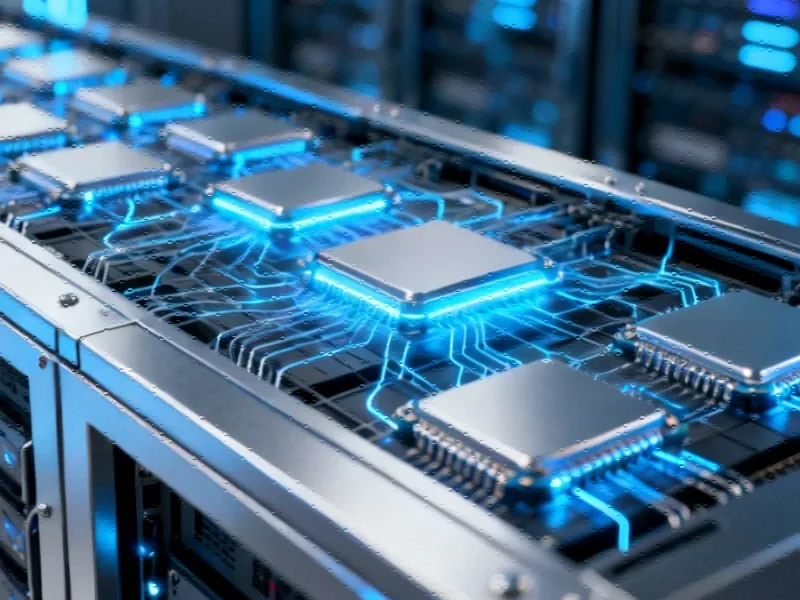Intel’s Hybrid AI Platform: A Calculated Ecosystem Partnership
In a significant strategic shift, Intel has developed a hybrid rack-scale AI platform that integrates its Gaudi 3 accelerators with NVIDIA’s Blackwell architecture. This unexpected partnership represents Intel’s acknowledgment that collaboration rather than direct competition may be the most viable path forward for its AI ambitions. The move comes as Intel seeks to maintain relevance in an AI market increasingly dominated by NVIDIA’s comprehensive ecosystem.
The hybrid configuration, unveiled at the OCP Global Summit, demonstrates Intel’s pragmatic approach to market challenges. Rather than attempting to displace NVIDIA entirely, Intel is positioning Gaudi 3 as a complementary technology that enhances specific aspects of AI inference workloads. This strategic alliance between Intel and NVIDIA represents one of the most significant hardware partnerships in recent AI infrastructure development.
Technical Architecture: Workload-Optimized Processing
The hybrid system employs a sophisticated workload distribution strategy that plays to each architecture’s strengths. NVIDIA’s Blackwell B200 GPUs handle the computationally intensive “prefill” stages of inference workloads, where their massive matrix multiplication capabilities excel. Meanwhile, Intel’s Gaudi 3 accelerators specialize in the “decode” portion, leveraging their memory bandwidth advantages and Ethernet-centric scale-out capabilities.
This division of labor makes technical sense given each platform’s architectural priorities. Blackwell GPUs demonstrate exceptional performance during initial context processing, while Gaudi 3’s design favors the sequential token generation typical of decode phases. The system’s networking infrastructure further enhances this synergy, utilizing NVIDIA’s ConnectX-7 400 GbE NICs and Broadcom’s Tomahawk 5 switches to maintain optimal data flow between components.
Rack-Scale Implementation and Performance Claims
Each compute tray in the system contains two Intel Xeon CPUs, four Gaudi 3 AI chips, four NICs, and one NVIDIA BlueField-3 DPU, with sixteen trays comprising a full rack. This configuration enables comprehensive all-to-all connectivity while maintaining thermal and power efficiency. According to initial reports from SemiAnalysis, the hybrid approach delivers 1.7x faster prefill performance compared to B200-only configurations on small, dense models.
While these performance claims await independent verification, the architectural approach suggests genuine potential for workload-specific advantages. The system represents Intel’s acknowledgment that competing directly with NVIDIA’s full-stack dominance requires creative solutions. As industry leaders continue to adapt their strategies in response to market realities, this hybrid model offers a template for pragmatic cooperation.
Market Implications and Strategic Considerations
Intel’s decision to integrate with NVIDIA’s ecosystem reflects broader industry developments toward interoperability and specialized processing. The “if you can’t beat them, join them” approach allows Intel to monetize its Gaudi investment while acknowledging NVIDIA’s ecosystem dominance. For NVIDIA, the partnership validates its networking technology and broader platform strategy.
However, significant challenges remain. Gaudi’s relatively immature software stack continues to limit adoption potential, and the architecture’s planned phase-out raises questions about long-term viability. These factors may constrain mainstream adoption despite the technical merits of the hybrid approach. The platform’s success will depend on enterprise willingness to embrace heterogeneous AI infrastructure.
Future Outlook and Industry Impact
This hybrid model could influence how other AI hardware providers approach market competition. Rather than attempting comprehensive alternatives to NVIDIA’s stack, companies may increasingly focus on developing specialized accelerators that complement existing ecosystems. This trend toward related innovations in cooperative hardware development could reshape the competitive landscape.
For enterprises, the hybrid approach offers potential cost efficiencies without requiring complete ecosystem migration. The ability to leverage Gaudi 3 for specific workload types while maintaining NVIDIA compatibility provides deployment flexibility. As AI workloads continue to diversify, such specialized configurations may become increasingly common in enterprise infrastructure.
Intel’s rack-scale solution demonstrates that the AI hardware market remains dynamic, with room for multiple players through strategic partnerships. While NVIDIA’s dominance continues, this hybrid model shows that complementary technologies can find market niches by addressing specific workload requirements within broader ecosystems.
This article aggregates information from publicly available sources. All trademarks and copyrights belong to their respective owners.
Note: Featured image is for illustrative purposes only and does not represent any specific product, service, or entity mentioned in this article.



